The coronation ceremony Charles III is about to go through reflects how monarchy has developed since Saxon times, but it still carries many vestiges of Britain’s imperial past.
In the 18th century, the royal title changed from “King of England” to “King of the United Kingdom”, as successive Acts of Union joined England, Scotland and Ireland into one political unit. However, the biggest change in the royal title came in 1876, when the Royal Titles Act made Queen Victoria Empress of India. This gave her authority even over those areas of India which were not formally subject to British rule.
To give this change of title a formal announcement in India, the British authorities staged what became the first of three durbars – ceremonial events held in the British Raj to formally proclaim the imperial title. Queen Victoria’s was held in 1877, the year following the act, but Edward VII’s and George V’s were held in conjunction with their coronations.
The viceroy of India in 1877, Lord Lytton, concocted the original durbar from a mixture of Persian, Mughal and English ceremonial traditions, as a formal proclamation of the queen’s title. When her son became Edward VII in 1901, a bigger durbar was organised to proclaim his imperial title – although, like his mother, Edward remained in London.
In 1911, George V and Queen Mary travelled to India for an elaborately staged coronation durbar, where they would take centre stage. This raised tricky questions of protocol.
George’s coronation in Westminster Abbey invested him with all his imperial titles, so what would be the impact of being “crowned” in India? Would it mean that his successors would not be emperors unless they held a durbar? And what did it mean for his predecessors who had not attended theirs? The crown of England was not allowed to leave the country, so a special crown was constructed for George V to wear in India, while Queen Mary wore her “best diadem” – a heavily ornamented headband. They sat sweating under the Delhi sun in their heavy coronation robes, furs and all.
In the end, the Delhi durbar consisted of Indian princes paying homage to the king-emperor in a ceremony that owed as much to European feudalism as it did to Indian tradition. Plans for George VI to have an Indian durbar were postponed in the post-abdication sense of general exhaustion, and abandoned as war loomed.
Coronation and the commonwealth The 1931 Statute of Westminster formalised the evolution of some former colonies into self-governing dominions within a British commonwealth. Both George VI and Elizabeth II were crowned as monarchs over the UK and of territories overseas. The coronation oath, a legal requirement dating back to the Coronation Oath Act of 1688, has been amended on various occasions, taking account of former colonies which have become republics.
The oath Charles III will take has been amended slightly to cover his duties to his other kingdoms by agreement with their governments. Even so, for the king of Canada to be crowned in London is a reminder that the modern monarch’s title still reflects the old empire.
Elements of empire Even the medieval roots of the coronation have elements of empire built into them. The Stone of Scone, which will be placed beneath the coronation chair, was removed from Scotland by Edward I as a symbol of Scotland’s subjugation to England. Scottish nationalists demanded the stone’s return to Scotland for years.
When John Major acceded to their wishes in 1996, it was on condition that the stone would return to Westminster for future coronations – a gesture some see as an unwelcome remnant of England’s imperial hold over Scotland, though others regard it as a symbol of unity.
In a nod to Welsh nationalist feeling, King Charles’s coronation will also include the kyrie (Lord Have Mercy) performed in Welsh.
One item of the crown jewels is a stark reminder of empire – but it will notably be missing from the coronation ceremony. The Koh-i-Noor diamond was taken by the British after their wars with the Sikh kingdom of Punjab, and presented to Queen Victoria in 1849.
It was reshaped by Prince Albert and fitted into the crown jewels. Both Queen Alexandra and Queen Mary wore it at their coronations, though Queen Mary, tactfully, did not wear it for the 1911 coronation durbar.
Seeing the diamond as symbol of British imperial acquisitiveness, the Indian government has demanded its return, though, historically, both Pakistan and Iran could also lay claim to it. Camilla, the Queen Consort, has decided to be crowned in Queen Mary’s crown, from which the famous diamond has been removed. The controversy about the Koh-i-Noor will doubtless continue, but won’t intrude on this coronation ceremony.
A new-look guest list The biggest move away from imperial tradition has been in the compilation of the guest list. In the past, the only rulers to receive an invite were those of British overseas territories, such as Queen Salote of Tonga, who delighted the crowds in 1953 by braving the rain in an open-top carriage and scorning an umbrella.
Charles III has departed from precedent by issuing invitations to monarchs from Europe and the Middle East, regardless of whether or not they had ties to the British empire. Some other heads of state are also attending, though the US will be represented by the first lady, Jill Biden, rather than the president.
At a time when polling suggests declining support for the monarchy, especially among the young, the coronation might seem an irrelevant, if colourful, distraction from more pressing concerns.
There has been similar indifference before other royal events. Elizabeth II’s silver jubilee in 1977 was preceded by “stuff the jubilee” protests, but still proved a popular success. The unexpectedly warm public responses to her subsequent jubilees, and especially to her funeral, might suggest that many British are secretly more royalist than polling would suggest.
By inviting representatives of a wide range of ethnic groups and different faiths to participate in the ceremony, the king is turning his coronation into a reflection of his diverse and decidedly post-imperial kingdom. The coronation is still not entirely free of echoes of empire, but it represents an important stage in the modern monarchy’s move away from its shadow.
By Sean LangSenior Lecturer in History, Anglia Ruskin University
(The Conversation)
PTI
Except for the headline, this story has not been edited by The Telegraph Online staff and has been published from a syndicated feed.











